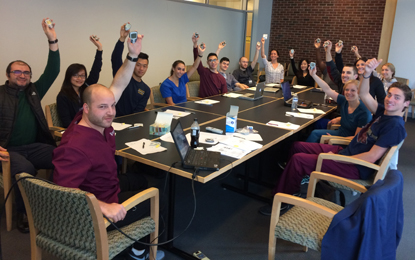Gary Hack, DDS clinical associate professor in the Department of Advanced Oral Sciences and Therapeutics at the University of Maryland School of Dentistry (UMSOD) has long advocated for the widespread adoption of glucose meters in dentistry. The use of these devices, which determine the approximate concentration of glucose in a patient’s blood, will position dentists to be at the front line of defense against the current diabetes epidemic.
“The majority of people who suffer with diabetes do not control their blood sugar levels adequately,” says Hack. “Dentists are in an ideal position to monitor their patients’ blood sugar levels to determine if they are in good control, as millions of individuals will see a dentist in the course of a year, but not see a medical doctor.”
This past March, Hack achieved a significant breakthrough: the ADA’s Code Maintenance Committee accepted his request to include the glucose meter test in their upcoming 2019 Publication titled “Codes on Dental Procedures and Nomenclature”.
This new code will allow dentists to accurately document specific treatments via electronic health records, provide for efficient processing of dental claims, and help standardize the use of glucose meters in dental practices.

A group of UMSOD students hold up glucose meters.
“This code adoption reflects the increasing awareness of the bidirectional relationship between diabetes and oral health,” says Hack.
Hack’s request was supported by letters from the Maryland Department of Health’s Office of Oral Health, as well as his UMSOD department chairman, Thomas Oates, DMD, PhD. “As periodontal disease is frequently one of the earliest clinical sequelae of diabetes, many patients with undiagnosed diabetes may initially enter the dental setting”, says Oates.
Currently, 86,000,000 people in the U.S. suffer with prediabetes, and 90 percent are unaware of their condition.
Hack appeared before the committee to answer questions during the ADA’s annual Code Maintenance Committee meeting held March 15 at the ADA Headquarters in Chicago. Ultimately, Hack’s request was one of only six codes to be accepted among the 66 that were submitted to the committee for consideration.
The use of glucose meters in dental practices will enable screening for diabetes and prediabetes, and will also help safe guard patients who require insulin and are at risk of becoming hypoglycemic during the course of a dental appointment, potentially placing the patient into a life-threatening situation.
“More and more dentists are testing their patients, because if a diabetic dental patient is about to undergo a long, complex procedure, it is helpful to know what their blood sugar level is at that moment”, says Christopher Bulnes, vice chair of the Council of Dental Benefit Programs.
For years, Hack has lobbied to expand the role of oral health providers in the battle against diabetes, as well as to increase research efforts into diabetes diagnosis and prevention. “Diabetes and prediabetes now affects 50% of the U.S. adult population and will bankrupt our healthcare system without intervention,” he says.
Hack serves as the American Diabetes Associations dental representative at the organization’s annual “Call to Congress”, during which the association advocates for accessible health care, affordable insulin, and funding for diabetes research. Moreover, Hack lobbied the ADA to include a section titled “Screening in Dental Practices” in their publication Standards of Medical Care in Diabetes, the first time a dentistry-specific section was included in the publication.



